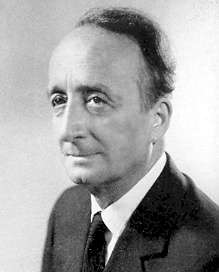Pietro Bucalossi
Pietro Bucalossi (9 August 1905 – 15 March 1992) was an Italian physician and politician. He is remembered for his research on cancer and his austerity and small government policies.[1][2]
Pietro Bucalossi | |
|---|---|
 | |
| Minister of Public Works | |
| In office 23 November 1974 – 12 February 1976 | |
| Prime Minister | Aldo Moro |
| Preceded by | Salvatore Lauricella |
| Succeeded by | Antonino Pietro Gullotti |
| Mayor of Milan | |
| In office 17 February 1964 – 13 December 1967 | |
| Preceded by | Gino Cassinis |
| Succeeded by | Aldo Aniasi |
| Member of the Chamber of Deputies | |
| In office 5 June 1968 – 19 June 1979 | |
| Constituency | Milan |
| In office 12 June 1958 – 17 February 1964 | |
| Constituency | Milan |
| Personal details | |
| Born | Pietro Enrico Alfredo Bucalossi 9 August 1905 San Miniato, Italy |
| Died | 15 March 1992 (aged 86) Milan, Italy |
| Political party | PdA (1942–47) PSDI (1947–68) PRI (1968–77) PLI (1977–79) |
| Alma mater | University of Pisa |
| Profession | Physician |
Biography
Born in San Miniato, in Tuscany, Pietro Bucalossi was graduate in medicine and surgery to the University of Pisa. He became a prominent oncologist and associate to the National Institute of Cancers (Istituto Nazionale dei Tumori, INT)[3] and moved to Milan in 1934. For all his live, he was member of the "Italian League for the Fight against Cancer" and also was Director of the INT from 1956 to 1974. He also wrote medical books with his protégé Umberto Veronesi.[4]
In 1940, he served as medical captain in the Italian Royal Army. After the 25 July (Mussolini's deposition), he left the army and entered in the Italian resistance and National Liberation Committee, as member of the Action Party. He was also distrust to the communists after the death of Benito Mussolini, for their role in the death's concealing.
In 1947, the Action Party disbanded and Bucalossi joined in to the Socialist Party of Italian Workers, that became the Italian Democratic Socialist Party in 1951. Representative for Milan to the Chamber of Deputies from 1958, in 1964 he resigned to become Mayor of Milan. Known for his strong personality and short temper, Bucalossi was a sincere supporter of the small government (despite his party's positions), similar to an American fiscal conservative.[2] He realised a bilance budget and austerity policies, cut the city spending and opposed to the growing regionalism and eventually useless Regional Councils, that he called "parlamentini" ("small parliaments"). However, he supported the early green politics (more public parks), the expansion of the Linate Airport and inaugurated the first Milan Metro line.[3] In 1967, he resigned as Mayor of Milan for lack support by his majority, like he opposed to the Unified PSI-PSDI. In 1968 Bucalossi was re-elected in the Chamber of Deputies for the Italian Republican Party, and in 1974 he became Minister of Public Works in the Aldo Moro's Cabinet. As Minister, he fight against the uncontrolled constructions creating a law on construction permit in 1977. In the same year, he left the Republicans for his opposition to the abortion (that he's party supported) and joined in to the Italian Liberal Party.
After his term end as representative, he left the politics and returned to his job as oncologist. He died in 1992.
References
- Massimo Emanuelli. "Pietro Bucalossi". Sistema Bibliotecario di Ateneo.
- Giulia Farsetti (7 August 2015). "Pietro Bucalossi: da San Miniato, un pioniere dell'oncologia che governò Milano". E di Empoli.
- Editorial Staff (31 July 2014). "Una via per Pietro Bucalossi, il sindaco della linea rossa". Milano Today.
- Umberto Veronesi; Alberto Costa (23 September 2009). L'uomo con il camice bianco. RCS MediaGroup. p. 230.
External links
